Pearl of East: Your travel guide in Uzbekistan.
|
Main Menu
Tashkent
Samarkand
Bukhara
Khiva
Baysun
Nukus
Margilan
Ferghana
Nurata
Namangan
Kokand
Sarmysh Say
Termez
|
News / НовостиUzbekistan: The work of Khorezm kandakori31/08/2015 14:28
In 1804 the came to power of the khans Kungratskoy dynasty. In the center of Khorezm in Khiva major construction work was begun, so thousands of artisans are beginning to engage in production. Gradually, the peoples with different languages began to speak a Turkic language. But some cultural identity of ancient Khorezm preserved to this day in some areas. This is clearly evident in the architecture and ornamental design of towns and villages in the subtleties of Applied Art Productions. Among the most popular items were masters kandakori that not only expertly treated metal, but were considered skilled Coppersmith, jewelers, masters of ornaments.
The word "Kandakor" in Persian means "thread". Because activity kandakori and masters of artistic metalwork interrelated.If master coppersmiths manufactured copper products, the kandakori carved patterns on them with steel pencils. Created in the late XIX and early XX centuries. Khorezm pottery, copper, and other products like arts and crafts products are very different from Fergana, Bukhara, Samarkand and other regions of Central Asia. Skilled craftsmen made artistic metal in Khiva, Khanka, mango, Kitchen Urgench Kungrad. They have contributed to the creation of the school kandakor. In the early twentieth century Khorezm kandakori on background pattern applied lacquer in black or red. The most favorite patterns are considered "aylanma islimi." Khorezm masters used islimi, complex islimi, madohimi, complex aylanma islimi. To do this, they used a hammer, anvil, tongs, pencils, etc. Hal. For example, water jar -kumgan characteristic of the inhabitants of Khiva has a slender neck, rounded body is capacious. In the form of kumgan clearly manifested one of the features of Khorezm products: conciseness and clarity of shape, freedom from unnecessary components (eg: from the handle, as it replaces the high neck of interception). The late Kandakor, master manufacturer of knife cutter Bakdurdy usto kumgans gives this definition: "In Khorezm kumgan compared with apricot, calling" mezhanadin beautiful. " The same comparison was used in the description of Girl beauties. Another vessel, which has a great demand - the "white kumgan" (akkumgan) or "Urganzhi." He is without a lid, a very simple, nickel-plated, on volume of slightly more than Khiva kumgan. Distinctive products are Khivans and copper snuff that are not produced in other regions of Uzbekistan. It is flat and round bottles from metal. They do not stand out for their ornamentation. In the ornament floral motifs predominate, for example: sarv- motif cypress flowers. It is worth noting that the products of Khiva masters of coinage strict and rich. They are not tinted background, using only black lacquer and red colors.
They carefully studied the Arabic alphabet, Arabic (kufy, Sula, nasta'liq) letter. And painted them in his works. Thus, to replace the fine arts have a new direction - applied art. The patterns gradually acquire a sophisticated look. There were developed characters, prayers, incantations and others. Each pattern has its value and write in different forms. The oldest form of pattern- madohil- three sheets. Its meaning: the eternity of the universe and time, a good word, a good idea, a good thing. Islimi- patterns are widely used and express values. "Hoshiya islim" (faceted islim), "Butov islim", "Turunzh islim" - these intertwined with each other (each other) patterns have infinite value of wealth and prosperity. A geometric patterns called "gireh" which in Persian means "twisted." Basically, these are geometric shapes as a "quadrilateral", "triangle", "circle", etc. Khorezm oasis has long been considered the center of arts and crafts where each master vldael several crafts. Even there the whole dynasty of the traditional handicraft of Khorezm. For example, the Khan's Palace was working craftsman Muhammadpano. NI Hradek writes that he had no equal engravers. He was a chaser, caster and engraver khan weapons workshops. His son was Hudaybergan chaser, musician, calligrapher, carver seals guns, the first watchmaker in Khiva. One of these artists was Hamid and foundations. His life took place in the courtyard of the Khan, where he was engaged in minting coins and stamps. In the early twentieth century in Khiva they lived and worked such masters as Matyakubov Janibekov, Hadzhiniyaz Saidniyazov, Bekzhan Yakubov, Atajan Madrimov and others. Despite the fact that many of them were skilled craftsmen, they used graphics Abdullah Baltaeva. Matyakubov Janibekov distinguished among others for his ability and skill in engraving jewelery, simkori in forging papers for carving stones. Therefore, his works were appreciated and Matyakubov spent his life in the palace of the Khan. Different work and Hadzhiniyaza Saidniyazova who coined with master Hamid (1920-1924 biennium) coins and medals for the former People's Republic of Khorezm (HNR). These works are different. Familiar with the works of masters Hadzhiniyaza collectors, local and foreign visitors (travelers) interested in its products, they have always been in demand. His work has been perfect, because he had a reputation among the people and respect for Khan. About the master potter Hadzhiniyaza usto- Eshmurad of Kunya Urgench mentions "Usto was not only an engraver, and a skillful ornamentalist, engraver and calligrapher, so master worked at the court for many years." Of course, the role of the coins in society is incomparable, because without them it is impossible to imagine the state. In the old days coins had another political force, that is, the gold and silver coins of the East were engraved name of the prophet and the ruler of the state, so they are very valued. Among the names of well-known masters and the name Sobirzhana Hudoyberganova, who is the son Hudaybergana Matchanov, that is the grandson Muhammadpano. He was not only an engraver, but also the organizer. After the overthrow of the government headed by Sabirzhzhanom many masters are beginning to work in special workshops. So there is a centralized needlework shop "Umid" ("Hope"). Masters stocking orders mostly at home. Khiva coppersmiths engaged in engraving. The son of Yakub mednika- usto Bekchan- etched patterns on objects made of copper, which he himself and produced. He was assisted by master - ornamentalist Abdullah chat. Today his descendants have created in Khiva mednichestva school where they teach their craft dozens of young people. Atajan Madraimov- master engraver, ornamentalist, chaser, who made elegant coinage handle knives. From his many inherited by his son Madraim. It is recognized by the people, izgotovlivaya the Republican Union of Masters of Folk arts and crafts beautifully designed handle and blade knives. He has taught his son in law and disciple of the late master Bekturdy Dzhumaniyazova and through it many young. Below is given information about the pedigree of this master and successor of his works: 1. Atajan Madraimov (1884-1916) - engraver, ornamentalist, master manufacturer of knives. 2. Madraim Atadzhanov - engraver, ornamentalist, master manufacturer of knives. 3. Bekturdy Dzhumaniyazov- engraver, ornamentalist, master manufacturer of knives and cutter. His pupil and son. 4. Ulugbek Masharipov- engraver, ornamentalist, master manufacturer of knives and cutter. Trainee. 5. Umrbek - engraver, ornamentalist, cutter. Brother. 6. Sanatbek- engraver, ornamentalist. Brother. Pupils: 7. Mukhtar Ibragimov- engraver, ornamentalist. 8. Alisher- engraver, ornamentalist. 9.Hursand- engraver. 10.Ravshan- engraver. The pupil and son-master Bekturdy, continuing the work of ancestors together with their students, in particular, with a young Ulugbek Masharipova participated in the decoration of many buildings in our country. In particular, the thread doing the foyer of the building's main train station, the city of Karshi, the central buildings of the city Pandzhikenta Tajikistan, carving cat, which was built in the XVI century Bobur Mirzo viloyats Osh in Kyrgyzstan. After independence master intended to re-open the shop and educate the younger generation here, but the sudden death took him from life. His student Ulugbek continues the work of the master. Since 1994, he became head of the circle prints in Khiva professional colleges in 1995-2000 opened a workshop in madrassas Muhammad Rahimkhan, which teaches the younger generation intricacies of kandakori. Over the years master involved with their work at the exhibition, carried out in Urgench, Tashkent, Alma-Ata. In an interview with master it became known that he is the great-grandson's maternal great Muhammad Pano. With master coppersmiths worked Bahadir Babadjanov, Davron Palvanov, grandson of the famous coppersmith Bekdjan usto Rustam Yakubov, Mansour and Dzhasur Matchanov. Usto Ulugbek died in 2000. His work continues to younger brothers Umrbek, Sanatbek, students Mukhtor, Alisher Masharif, Ravshan, Khursand. And today coppersmiths transmit their work engravers, and they in turn do with these products great designs, turning them into finished products. |
Calendar
Weather
Useful Links
Searching for Airways and Hotels
|
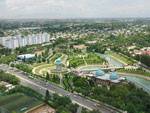
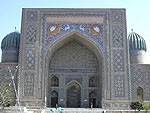
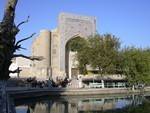
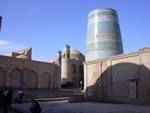
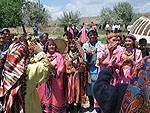
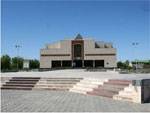
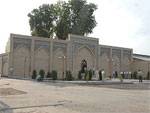
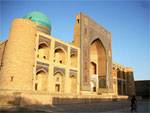
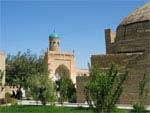
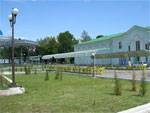
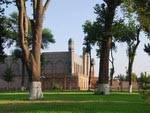
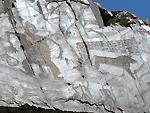
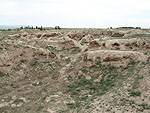
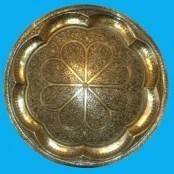 The ancient culture and traditions of Khorezm are different from other regions of Central Asia, a multi-faceted originality, Khorezm language and script, color flower jewelry and clothing, etc. Despite numerous invasions of the Arabs and the Mongols, the relocation to this area of various nomadic inhabitants of this fertile land retained their national values. However, internal wars adversely affect the growth of the population of the oasis, on the life and culture of the inhabitants. In particular, in the Middle Ages there is a significant crisis in the applied arts, which lasted until the beginning of the XIX century until the rebirth of centralized government.
The ancient culture and traditions of Khorezm are different from other regions of Central Asia, a multi-faceted originality, Khorezm language and script, color flower jewelry and clothing, etc. Despite numerous invasions of the Arabs and the Mongols, the relocation to this area of various nomadic inhabitants of this fertile land retained their national values. However, internal wars adversely affect the growth of the population of the oasis, on the life and culture of the inhabitants. In particular, in the Middle Ages there is a significant crisis in the applied arts, which lasted until the beginning of the XIX century until the rebirth of centralized government.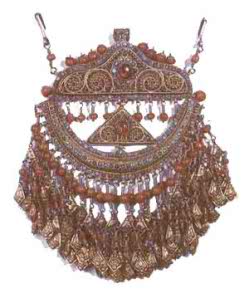
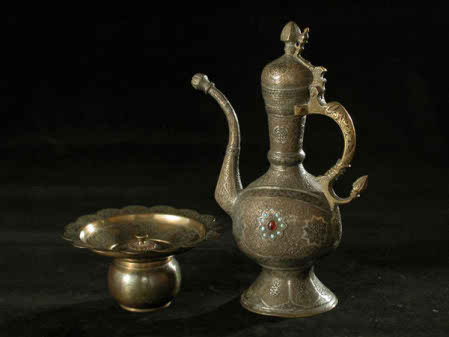 Watching them can not help recalling the words of S. Tolstov, where he wrote about the ancient art of Khorezm, "The Art of Khorezm is easy and free ways to influence by excessive finesse, but at the same time, it has an abundance of values. Attractive fine art of Sogd. " Under the influence of Islam are no longer masters depict animals, birds and humans, but instead was part of the art of a different direction. Now mastera- artists represented in his works nature, colors, different patterns.
Watching them can not help recalling the words of S. Tolstov, where he wrote about the ancient art of Khorezm, "The Art of Khorezm is easy and free ways to influence by excessive finesse, but at the same time, it has an abundance of values. Attractive fine art of Sogd. " Under the influence of Islam are no longer masters depict animals, birds and humans, but instead was part of the art of a different direction. Now mastera- artists represented in his works nature, colors, different patterns.